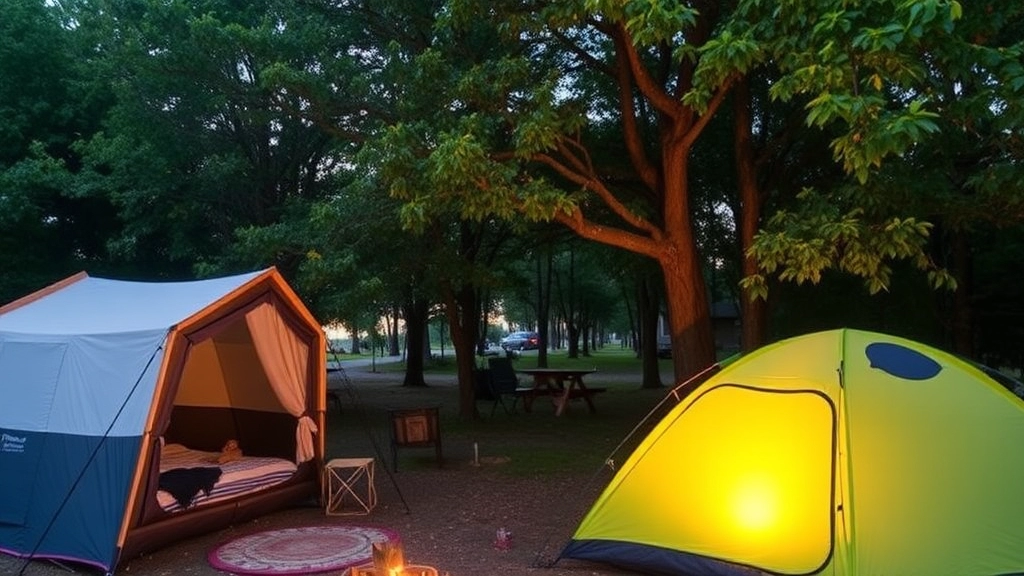Summer Tent Camping: Tips for Staying Cool
When it comes to summer tent camping, staying cool, comfortable, and safe is key. From choosing the right gear to finding the perfect campsite, there are several strategies you can use to beat the heat. In this guide, I’ll share practical tips on how to make your summer camping experience enjoyable, even when temperatures soar.
Choosing the Right Gear
First, let’s talk about the best camping gear for summer tent camping. Opt for lightweight, breathable tents that offer good ventilation. Position your tent in shaded areas and use cooling accessories like portable fans or reflective tarps. These simple adjustments can make a big difference in keeping your sleeping area cool and comfortable.
Best Camping Gear for Summer Tent Camping
Ever found yourself sweating buckets in your tent, wondering if there’s a better way to do summer camping? You’re not alone. Let’s dive into the best camping gear you need for a cool, comfortable summer adventure.
The Right Tent for Summer
First things first, you need a tent that’s built for summer. It’s got to be breathable, lightweight, and easy to set up and take down. Look for these features:
- Mesh Panels: Maximise airflow with large mesh panels.
- Double-Wall Design: Keeps the bugs out while letting the breeze in.
- Lightweight Material: Easier to carry and less heat retention.
Sleeping Gear to Keep You Cool
Forget the heavy sleeping bags. You want something light and airy. Here’s what I recommend:
- Sleeping Pads: Go for inflatable or foam pads that offer comfort without the heat.
- Lightweight Sleeping Bags: Opt for bags rated for warmer temperatures or even a sleeping bag liner.
- Camping Pillows: Compact and cool, these make a huge difference in comfort.
Cooking Gear for Easy Meals
You don’t want to be slaving over a hot stove. Here are some cool cooking gear tips:
- Portable Grills: Easy to set up and perfect for quick meals.
- Coolers: Invest in a high-quality cooler to keep your food and drinks chilled.
- Compact Cookware: Lightweight pots and pans that pack easily.
Hydration Essentials
Staying hydrated is non-negotiable. Here’s what you need:
- Hydration Packs: Convenient and easy to carry.
- Water Bottles: Go for insulated bottles to keep your water cool.
- Water Filters: Essential if you’re getting water from natural sources.
Clothing and Accessories
What you wear can make or break your camping experience. Go for:
- Moisture-Wicking Clothing: Keeps sweat at bay.
- Hats and Sunglasses: Protects you from the sun.
- Lightweight Jackets: For those cooler evenings.
Gadgets and Gizmos
Finally, a few gadgets can make your summer camping trip even better:
- Portable Fans: USB or battery-operated fans can be a lifesaver.
- Solar Chargers: Keep your devices powered without needing an outlet.
- Lanterns: Lightweight and bright, perfect for those summer nights.
Real Stories, Real Gear
I remember a trip where I packed a heavy sleeping bag, thinking it would be fine. Big mistake. I ended up sweating all night and barely slept. Since then, I’ve switched to a lightweight sleeping bag liner, and it’s been a game changer.
So, whether you’re a seasoned camper or a newbie, having the right gear can make all the difference. Trust me, you don’t want to learn the hard way. For more tips on making your summer adventures unforgettable, check out our ultimate guide to summer camp bonfire fun and explore the best summer camp chairs to bring along.
How to Choose the Perfect Summer Tent
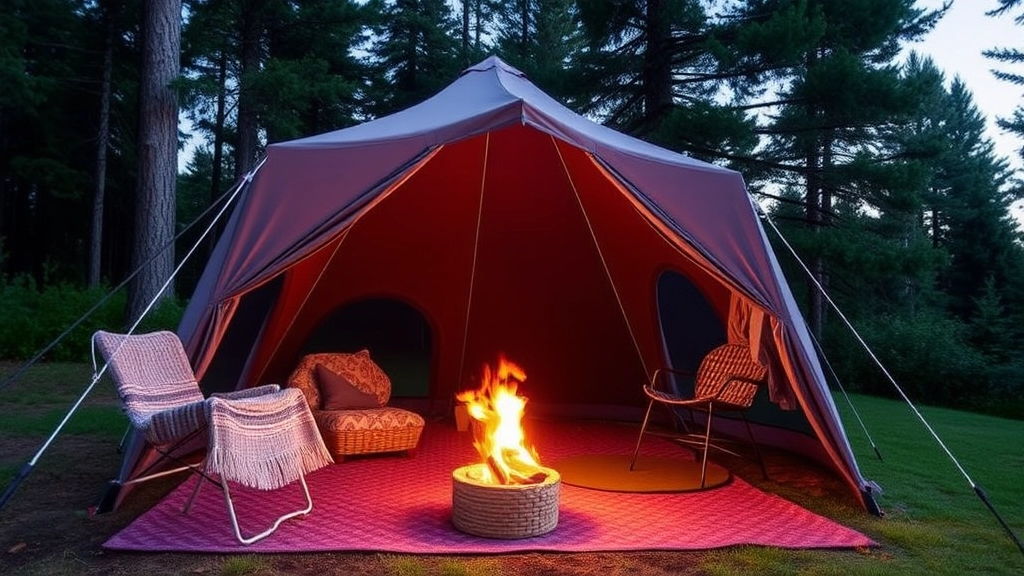
Alright, let’s dive in.
Choosing the perfect summer tent can be a headache.
But it doesn’t have to be.
Here’s the lowdown.
What Makes a Summer Tent Perfect?
You need a tent that keeps you cool, dry, and comfy.
Here are the must-haves:
- Ventilation: Summer camping means heat. Look for tents with plenty of mesh windows and vents. This keeps the air flowing and the sweat at bay.
- Material: Lightweight, breathable fabric is key. Avoid heavy, dark materials that trap heat.
- Size: Consider the number of campers and gear. You don’t want to be crammed in like sardines.
- Ease of Setup: Quick and simple. You don’t want to spend hours fiddling with poles in the blazing sun.
- Weather Resistance: Summer can bring sudden showers. Ensure your tent is water-resistant but still breathable.
Ventilation: The Game Changer
You’ve got to keep that air moving.
Look for these features:
- Mesh Panels: Large mesh windows and doors.
- Roof Vents: Hot air rises, so vents at the top let it escape.
- Dual Doors: More doors mean better airflow.
Material Matters
The fabric can make or break your summer camping experience.
- Polyester: Lightweight and quick-drying.
- Nylon: Durable and breathable.
- Canvas: Breathable but heavier and pricier.
Size and Space
Think about who’s joining you.
- Solo or Duo: A 2-person tent is usually enough.
- Family or Group: Go for a 4-person or larger.
- Gear: Extra space for backpacks, coolers, and other essentials.
Quick Setup
No one wants to wrestle with a tent for hours.
- Pop-Up Tents: Super fast, but might lack durability.
- Instant Tents: Quick setup with pre-attached poles.
- Traditional Tents: More work but often sturdier.
Real Talk: My Experience
I once picked a tent that looked great online.
But it was a nightmare to set up.
And it turned into a sauna by noon.
Lesson learned: Always check ventilation and ease of setup.
Weather-Proofing
Summer storms can hit out of nowhere.
- Waterproof Rating: Check the hydrostatic head rating.
- Sealed Seams: Keeps the water out.
- Rainfly: A removable cover that provides extra protection.
Essential Tips for Staying Cool in a Tent
Ever been stuck in a tent that feels like a sauna? Yeah, me too. Summer camping can be a blast, but it’s no fun when you’re sweating buckets. Here’s how to keep your cool, literally.
Choose the Right Tent
First things first, pick a tent designed for summer camping. Look for:
- Breathable materials: Think mesh windows and panels.
- Ventilation options: Multiple windows and roof vents.
- Light colours: Dark tents absorb heat; go for lighter shades.
Set Up in the Shade
Location, location, location. When setting up your tent, find a spot with natural shade. Trees are your best mates here. Avoid direct sunlight like the plague.
Use a Reflective Tarp
Ever heard of a reflective tarp? It’s a game-changer. Place it over your tent to deflect the sun’s rays. Trust me, it makes a world of difference.
Ventilation is Key
Open up those windows and vents. Create cross-ventilation by opening windows on opposite sides. If your tent has a roof vent, use it. Fresh air in, hot air out.
Invest in a Camping Fan
A small, battery-operated fan can be a lifesaver. Place it near the door or window to boost airflow. If you’re feeling fancy, go for a solar-powered fan.
Stay Hydrated
This one’s a no-brainer but easy to forget. Drink plenty of water. Keep a bottle handy and sip regularly. Dehydration is sneaky and can ruin your trip.
Cool Down Before Bed
Here’s a trick: wet a bandana and place it on your neck or forehead. You can also use a spray bottle with water to mist yourself. Instant cool down.
Wear Light Clothing
Opt for light, breathable fabrics. Cotton and moisture-wicking materials are your best friends. Avoid dark colours; they absorb heat.
Sleep on a Cot
If you can, sleep on a cot rather than a sleeping pad. Elevating yourself off the ground allows air to circulate underneath, keeping you cooler.
Create an Ice Breeze
Fill a shallow pan with ice and place it in front of your fan. Instant air conditioning. Just make sure the pan doesn’t tip over.
Keep Electronics Cool
Your gadgets can overheat too. Store them in shaded areas and avoid direct sunlight. A small, insulated cooler can help keep them at a safe temperature.
Setting Up Your Tent in the Right Location
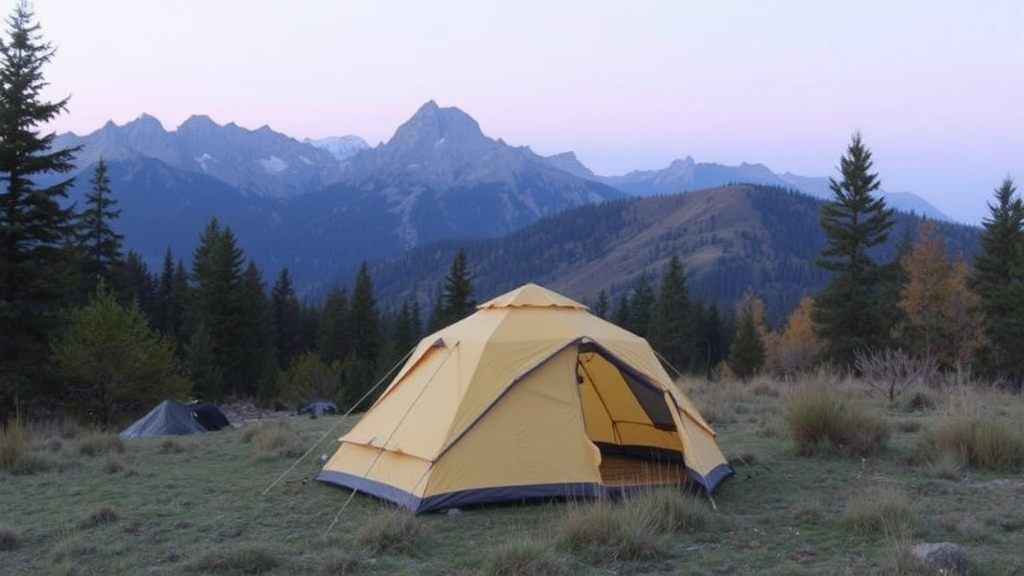
Finding the perfect spot to set up your tent can make or break your summer camping experience.
Ever woken up in a tent that feels like a sauna? Or maybe you’ve pitched up on a slope and spent the night sliding downhill? Yeah, we’ve all been there.
So, let’s get this right.
Look for Shade
First thing’s first: shade.
You don’t want to wake up to the blazing sun cooking you alive.
Find a spot that offers natural shade, like under a tree.
But be cautious of dead branches – you don’t want those falling on your tent.
Flat Ground is Your Friend
You need flat ground.
Sleeping on a slope is a recipe for discomfort.
Check the area for rocks, roots, and any other nasties lurking under the surface.
A quick sweep with your foot can save you a night of tossing and turning.
Avoid Low Spots
Low spots can turn into puddles if it rains.
Nothing worse than waking up in a tent that’s become a mini swimming pool.
Look for higher ground to keep dry.
Consider the Wind
Wind can be a double-edged sword.
A gentle breeze? Perfect for keeping cool.
A gale-force wind? Not so much.
Position your tent with the back facing the wind to reduce drag and keep it stable.
Proximity to Water
Being close to water is a bonus for staying cool.
But don’t pitch too close.
Rivers can rise, and mosquitoes love water.
Keep a safe distance – about 200 feet is ideal.
Privacy and Quiet
Privacy matters.
Find a spot away from the main trails and other campers.
It’s your escape, after all.
Plus, fewer people means less noise.
Real-Life Example
Last summer, I found a gem of a spot under a big oak tree, on a flat patch of ground.
Had a gentle breeze coming off the nearby lake.
Perfect setup.
Stayed cool all day and slept like a baby.
Quick Checklist
- Shade: Natural cover to avoid the morning sun.
- Flat Ground: No slopes, rocks, or roots.
- Avoid Low Spots: Stay dry if it rains.
- Consider Wind: Position tent back to the wind.
- Proximity to Water: Close enough for convenience, far enough for safety.
- Privacy and Quiet: Away from main trails and other campers.
Innovative Ways to Keep Your Tent Ventilated
Ever been in a tent that feels more like a sauna than a sanctuary? Yeah, me too. Keeping your tent ventilated during those scorching summer nights can be a real game-changer. But how do you do it without turning your camping trip into a hot mess? Let’s dive into some innovative ways to keep your tent ventilated and make your summer camping experience a breeze.
Real Questions and Worries
- “Why does my tent feel like a furnace?”
- “Is there a way to keep my tent cool without buying expensive gear?”
- “How can I make sure my family is comfortable in the tent all night?”
These are the questions that keep us campers up at night, literally. So, let’s break down some practical solutions.
Choose the Right Tent
First things first, if your tent is a heat trap, no amount of ventilation tricks will save you. Opt for a tent designed with summer camping in mind:
- Mesh Panels: Look for a tent with plenty of mesh panels. These allow for maximum airflow while keeping bugs out.
- Double-Walled Tents: These are great because they have a breathable inner layer and a waterproof outer layer, allowing for better ventilation.
Strategic Tent Placement
Where you set up your tent can make all the difference:
- Shade: Pitch your tent in a shaded area. Trees are your best friends here.
- Elevation: If possible, set up your tent on a slight elevation to catch any breeze that comes your way.
- Orientation: Position your tent so the doors and windows face the direction of the prevailing wind.
Ventilation Hacks
Here are some easy hacks to boost airflow in your tent:
- Open All Vents: This might sound obvious, but many people forget. Open all the vents to allow air to circulate.
- Use a Tarp: Set up a tarp over your tent but leave a gap for airflow. This provides shade and a layer of insulation.
- Portable Fans: Battery-operated fans can be a lifesaver. Place them near the vents to enhance airflow.
- Reflective Sunshade: Use a reflective sunshade over your tent to deflect the sun’s heat.
DIY Ventilation Solutions
Sometimes, the best solutions are the simplest:
- Wet Towels: Hang wet towels inside your tent. As they dry, they cool the air.
- Cold Packs: Place cold packs or frozen water bottles around your tent. These act as mini air conditioners.
- Ventilation Holes: If you’re handy, consider adding extra ventilation holes to your tent. Just make sure you can seal them up if needed.
Night-Time Ventilation
Keeping your tent cool at night is crucial for a good night’s sleep:
- Night Breeze: If there’s a cool breeze at night, make sure your tent is positioned to catch it.
- Open Windows: Leave the windows open, but secure the mesh to keep bugs out.
- Minimal Bedding: Use lightweight, breathable bedding to avoid overheating.
Real-Life Example
Last summer, I was camping in the Peak District with my family. It was a scorcher, and our tent felt like an oven. We tried hanging wet towels and using a portable fan, but what really made a difference was setting up a tarp for shade and positioning our tent to catch the evening breeze. It was like night and dayâliterally.
For more ideas on how to make your camping experience enjoyable, check out our fun and creative summer camp projects. And if you’re planning to camp in a wooded area, don’t miss our guide on the benefits and activities of wooded area summer camps.
Cooling Accessories and Gadgets for Summer Camping
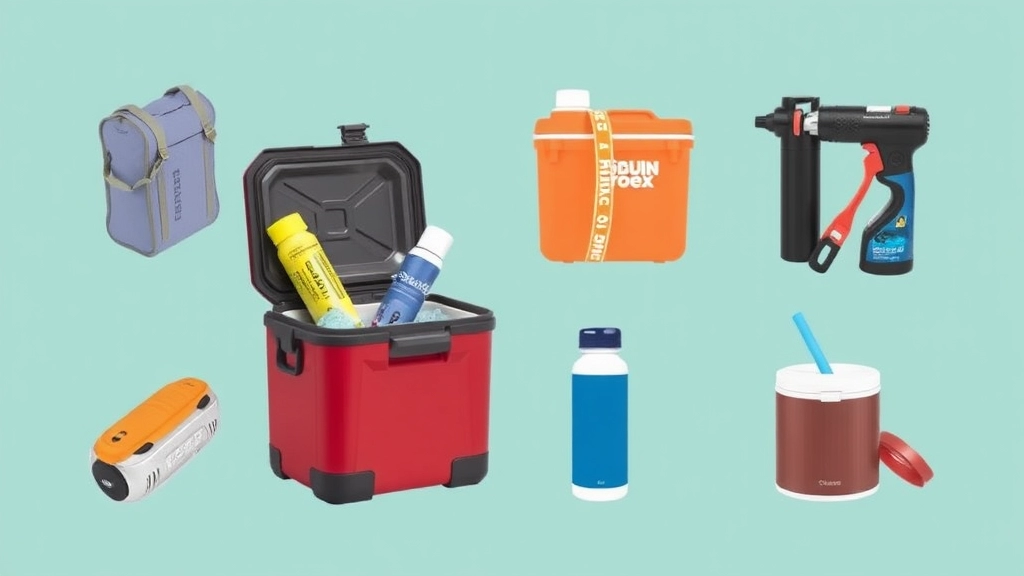
Ever been stuck in a sweltering tent, sweating buckets and wondering why you didn’t pack better gear?
Yeah, me too.
Let’s dive into some top-notch cooling accessories and gadgets that’ll keep you chill during your summer camping adventure.
Portable Fans
First up, portable fans.
These little lifesavers can make a world of difference.
- Battery-powered fans: No power outlet? No problem. These fans run on batteries and are super easy to use.
- USB fans: Got a power bank? Plug in a USB fan and you’re good to go.
Cooling Towels
Next, let’s talk cooling towels.
These are a game-changer.
- Quick-dry fabric: Just wet them, wring them out, and snap them. They stay cool for hours.
- Compact and lightweight: Easy to pack and carry around.
Reflective Tarps and Sunshades
Ever thought about using reflective tarps?
- Reflective material: They bounce the sun’s rays away from your tent, keeping it cooler.
- Easy setup: Just drape it over your tent or set it up as an extra shade.
Tent Air Conditioners
Okay, this one’s a bit more high-tech: tent air conditioners.
- Portable AC units: These can be a bit bulky, but they’re worth it if you’re camping in extreme heat.
- Evaporative coolers: A more compact option that uses water to cool the air.
Cooling Gel Pads
Ever tried cooling gel pads?
- Multi-use: You can sit on them, sleep on them, or use them as a pillow.
- Reusable: Just pop them in the cooler or fridge, and they’re ready to go again.
Solar-Powered Gadgets
Let’s not forget solar-powered gadgets.
- Solar fans: Eco-friendly and efficient. They run as long as the sun’s out.
- Solar chargers: Keep your other gadgets powered up without needing a plug.
Personal Misters
Last but not least, personal misters.
- Handheld misters: Fill them with water, and they spray a fine mist to cool you down.
- Battery-operated misters: These can provide a continuous mist, perfect for those really hot days.
Managing Food and Drink to Stay Cool
Ever found yourself sweating buckets in a tent, wondering how on earth you’re supposed to keep your food and drink cool? Let’s be real â it’s a common worry for anyone heading out for a summer camping trip. No one wants to deal with warm drinks and spoiled food. So, how do you manage food and drink to stay cool while camping in the summer? Here’s the lowdown.
Keep It Cool from the Start
First things first, pre-chill everything. Before you even leave the house, make sure your drinks and perishables are as cold as possible. This gives you a head start in keeping things cool.
Choose the Right Cooler
Not all coolers are created equal. Invest in a good quality cooler that offers excellent insulation. Look for coolers with thick walls and tight seals. Rotomolded coolers are top-notch if you’re willing to splurge a bit.
Ice Hacks
Ice is your best friend. But instead of just dumping a bag of ice into your cooler, try these tricks:
- Use block ice: It melts slower than cubed ice.
- Freeze water bottles: They double as ice packs and provide drinking water as they melt.
- Dry ice: If you’re going for an extended trip, dry ice can keep things super cold, but handle it with care.
Pack Smart
How you pack your cooler matters. Layering is key:
- Start with a layer of ice at the bottom.
- Place your most perishable items next.
- Add another layer of ice.
- Top it off with less perishable items.
Remember to keep your cooler out of direct sunlight and avoid opening it too often. Every time you open it, you let the cold air out.
Hydration Station
Keeping hydrated is crucial. Cold water is refreshing, but you can level up by adding a few slices of cucumber or mint leaves to your water bottles before freezing them. It’s like having a mini spa day in your tent.
Snack Wisely
Opt for snacks that don’t require refrigeration. Think:
- Nuts and seeds
- Dried fruits
- Energy bars
For a cool treat, bring some frozen grapes or homemade fruit popsicles. They’re not only refreshing but also provide a quick energy boost.
Mealtime Magic
Cooking in the heat can be a drag. Stick to light and easy meals:
- Salads: Use pre-washed greens and add toppings like canned beans, nuts, and dried fruits.
- Wraps: Fill tortillas with hummus, veggies, and pre-cooked chicken.
- Cold pasta dishes: Cook and chill your pasta before you leave, then mix with veggies and a light dressing.
Stay Organized
Keep your food and drinks in separate coolers if possible. This way, you’re not constantly opening the cooler with your perishables, which helps in maintaining a lower temperature inside.
Preparing for Summer Nighttime Comfort
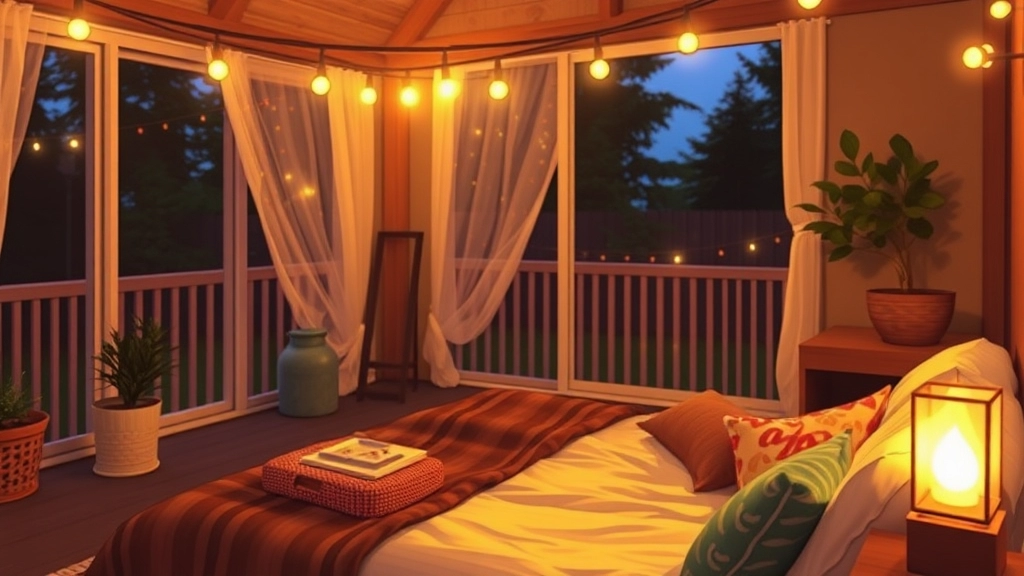
Ever tried to sleep in a tent when it’s hotter than a sauna?
Yeah, it’s brutal.
But don’t worry, I’ve got you covered. Let’s make sure your summer nights are as cool and comfy as possible.
Key Concerns
- How do I stay cool at night?
- What gear do I need for a good night’s sleep?
- How can I avoid waking up drenched in sweat?
The Essentials for a Cool Night
1. Choose the Right Sleeping Bag
- Lightweight and breathable: Opt for a sleeping bag rated for summer temperatures.
- Material matters: Go for synthetic over down; it’s better for moisture control.
2. Sleeping Pads and Air Mattresses
- Elevate yourself: A good sleeping pad or air mattress keeps you off the hot ground.
- Insulation: Some pads come with built-in insulation to keep you cool.
3. Cooling Sheets and Liners
- Bamboo or cotton: These materials are breathable and help wick away sweat.
- Cooling liners: Some liners are designed to keep you cool, perfect for hot nights.
Ventilation is Key
1. Tent Placement
- Shade is your friend: Set up your tent under trees or any natural shade.
- Catch the breeze: Position your tent to take advantage of any wind.
2. Tent Features
- Mesh panels: These allow for better airflow.
- Double doors: Open them up to create a cross breeze.
Gadgets and Accessories
1. Portable Fans
- Battery-operated: These are a lifesaver in a stuffy tent.
- Clip-on fans: Attach them to the tent for direct airflow.
2. Cooling Towels
- Quick-dry and reusable: Wet them, wring them out, and place them on your skin.
- Perfect for hot nights: Lay them over your sleeping bag for an extra layer of cool.
Real-life Example
Last summer, I was camping in the Peak District.
The day was scorching, and I dreaded the night.
But with a lightweight sleeping bag, a cooling towel, and my trusty portable fan, I slept like a baby.
Safety Tips for Heat and Hydration During Summer Camping
Alright, let’s get real here. Summer camping can be a blast, but it can also be a scorcher. How do you keep from turning into a puddle of sweat and make sure you stay hydrated? Let’s dive into some practical tips to keep you cool and safe.
The Heat is On: How to Stay Cool
First things first, you’ve got to manage the heat. We’ve all been there â sweating buckets, feeling dizzy, and just plain uncomfortable. Here’s how to keep your cool:
- Wear Light, Breathable Clothing: Think cotton and moisture-wicking fabrics. Trust me, you’ll thank yourself later.
- Stay in the Shade: Set up your tent and hangout spots under trees or bring along a canopy. Direct sunlight is your enemy.
- Take Frequent Breaks: Don’t push yourself too hard. Rest often, especially during the hottest part of the day (11 AM to 3 PM).
- Use Cooling Towels: These can be a lifesaver. Just wet them, wring them out, and drape them around your neck.
- Plan Activities for Cooler Times: Early mornings and late evenings are your friends. Save the strenuous stuff for these times.
Hydration: The Key to Survival
Hydration isn’t just about drinking water. It’s about making sure your body has what it needs to function well in the heat. Here’s how to do it:
- Drink Plenty of Water: This is a no-brainer, but it’s worth repeating. Aim for at least 2-3 litres a day.
- Electrolytes Are Your Friend: Water alone isn’t enough. Pack some electrolyte tablets or sports drinks to replenish lost salts.
- Avoid Alcohol and Caffeine: Sorry to be a buzzkill, but these can dehydrate you faster. Save the beers for the evening when it’s cooler.
- Eat Water-Rich Foods: Fruits like watermelon, oranges, and cucumbers are not only tasty but help keep you hydrated.
- Set Reminders to Drink: It’s easy to forget when you’re having fun. Set a timer on your phone to remind you to take a sip every hour.
Real Talk: What to Watch Out For
Heat exhaustion and heatstroke are no jokes. Here’s what to look out for and what to do if things get serious:
- Signs of Heat Exhaustion:
- Heavy sweating
- Weakness or fatigue
- Dizziness or fainting
- Nausea or vomiting
- Headache
- What to Do:
- Move to a cooler place
- Drink cool water or sports drinks
- Apply cool, wet cloths to your skin
- Loosen clothing
- Signs of Heatstroke:
- High body temperature (above 40°C)
- Hot, red, dry, or damp skin
- Rapid and strong pulse
- Confusion or unconsciousness
- What to Do:
- Call emergency services immediately
- Move to a cooler environment
- Use cool cloths or a cool bath to lower body temperature
- Do NOT give fluids if the person is unconscious
Personal Experience: A Lesson Learned
I remember my first summer camping trip like it was yesterday. I thought I was invincible, guzzling down energy drinks and skipping the water. By midday, I was feeling lightheaded and nauseous. I learned the hard way that staying hydrated and cool is non-negotiable. Don’t make the same mistake I did!
If you’re looking for more tips on how to stay cool during your summer adventures, check out our guide on how to stay cool and beat the heat. And for those planning to camp with kids, our article on engaging summer camp ice breaker games can help keep everyone entertained and active during the cooler parts of the day.
Summer Camping Activities to Beat the Heat
Ever found yourself melting in the summer heat while camping?
We’ve all been there.
Keeping cool is key, and it’s easier than you think.
Here are some top-notch activities to help you beat the heat and enjoy your summer camping trip.
Water-Based Fun
First up, water activities are your best friend.
- Swimming: If you’re near a lake or river, dive in. Nothing cools you down like a good swim.
- Kayaking/Canoeing: Glide across the water and feel the breeze. It’s a workout and a cool-down all in one.
- Fishing: Sit by the water, cast your line, and relax. It’s peaceful and keeps you cool.
Shady Adventures
Next, let’s talk about staying out of the sun.
- Hiking in the Early Morning or Late Evening: Avoid the midday sun. The trails are cooler, and the views are just as stunning.
- Forest Walks: Trees provide natural shade. Wander through the woods and stay cool under the canopy.
- Reading or Napping in a Hammock: Find a shady spot, string up your hammock, and chill out with a good book or a nap.
Cool Gadgets and Games
Sometimes, a little tech can make a big difference.
- Portable Fans: Bring a battery-operated fan. It’s a game-changer when the air is still.
- Misting Bottles: Fill a spray bottle with water and mist yourself. Instant refreshment.
- Board Games and Cards: Set up a game in the shade. It’s fun and keeps you out of the sun.
Nighttime Comfort
The evenings can be a relief.
- Stargazing: Lay back and watch the stars. The night air is cooler, and it’s a magical experience.
- Campfire Stories: Gather around the fire and share stories. It’s cooler at night, and the fire adds a cozy touch.
- Night Hikes: Explore the trails under the moonlight. It’s cooler and adds a sense of adventure.
Stay Hydrated and Energised
Finally, don’t forget the basics.
- Drink Plenty of Water: Keep hydrated. It’s essential for staying cool and healthy.
- Eat Light: Heavy meals can make you feel hotter. Opt for light, refreshing foods like fruits and salads.
So, the next time you’re camping in the summer, don’t sweat it.
Literally.
Use these activities to stay cool and make the most of your trip.
After all, summer camping should be about fun, not frying in the heat.
Stay cool, stay safe, and enjoy every moment.
For more ideas on how to make your camping trip memorable, check out our Ultimate Summer Camp Planning Checklist. And if you’re looking for fun and creative activities, don’t miss our Summer Camp Drawing Ideas.
Happy camping!
FAQs on Summer Tent Camping
How do I choose the perfect summer tent?
Choosing the perfect summer tent involves considering factors like ventilation, material, size, ease of setup, and weather resistance. Look for tents with plenty of mesh windows, lightweight breathable fabric, adequate space for campers and gear, and quick setup features.
What makes a summer tent ideal for hot weather?
An ideal summer tent should have excellent ventilation with large mesh windows and vents, be made of lightweight and breathable materials, and offer easy setup to avoid prolonged exposure to the sun.
Why is ventilation important in a summer tent?
Ventilation is crucial to keep the air flowing and prevent the tent from becoming unbearably hot. Features like mesh panels, roof vents, and dual doors enhance airflow and comfort.
What are the best materials for a summer tent?
For summer camping, tents made of polyester, nylon, or canvas are ideal. Polyester is lightweight and quick-drying, nylon is durable and breathable, and canvas, though heavier, offers excellent breathability.
How do I set up my tent in the right location?
Choose a spot with natural shade, flat ground, and avoid low spots that can collect water. Consider the wind direction and maintain a safe distance from water sources while ensuring privacy and quiet.
What cooling accessories are useful for summer camping?
Essential cooling accessories include portable fans, cooling towels, reflective tarps, tent air conditioners, cooling gel pads, solar-powered gadgets, and personal misters.
How can I stay cool at night while camping in summer?
To stay cool at night, use a lightweight and breathable sleeping bag, a good sleeping pad or air mattress, and cooling sheets or liners. Ensure your tent is well-ventilated and consider using portable fans and cooling towels.
What are the key features to look for in a summer sleeping bag?
Look for a sleeping bag that is lightweight, breathable, and rated for summer temperatures. Synthetic materials are preferable over down for better moisture control.
How do I ensure my tent remains cool during the day?
Set up your tent in a shaded area, use reflective tarps to deflect sunlight, and ensure good ventilation with mesh panels and dual doors. Portable fans can also help maintain a cooler environment inside the tent.
What should I consider when choosing a tent size?
Consider the number of campers and the amount of gear you have. A 2-person tent is usually sufficient for solo or duo camping, while a 4-person or larger tent is better for families or groups. Extra space for gear is also important.
References
-
REI Expert Advice: How to Choose a Tent
-
OutdoorGearLab: Best Camping Tents of 2024
-
CleverHiker: Best Backpacking Tents

